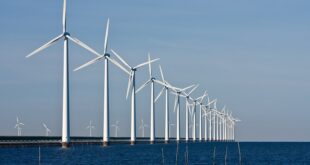Renewable energy installations reached record highs in 2023, growing at their fastest pace in decades. 510 gigawatts (GW) of renewable energy were added worldwide, representing a 50% increase from 2022, according to figures from the International Energy Agency (IEA)’s annual flagship report on the global status of renewable energy. Projections show that the sector’s expansion will continue to accelerate, with an anticipated 2.5-fold increase by 2030. While this is a promising trend in the right direction, however, experts say that it’s not enough to reach global climate goals.
At last year’s COP28 climate conference, held by the United Nations in Expo City, Dubai, United Arab Emirates, attending governments agreed to fully triple global renewable energy production capacity by 2030. This will require a serious acceleration of current trends and expanded policy measures to support that acceleration. According to IEA Executive Director Fatih Birol, the main hurdle between the current state of the sector and the pathway to 3x growth by 2030 is the necessary increase of funds for clean energy in developing countries. “Success in meeting the tripling goal will hinge on this,” he said.
“Under current policies and market conditions, global renewables capacity is forecast to grow to a total of 7,300 GW by 2028,” Reuters recently reported. “To reach the 2030 goal agreed last year, it will require reaching at least 11,000 GW.” But thanks to the recent surges in renewables, meeting those goals is still feasible, as long as annual growth in renewables reaches at least 320 gigawatts by 2030. And that goal is within reach with proper coordination from the public and private sectors.
In fact, seven nations around the world now generate 100% (>99.7%) of their energy from renewable resources. According to figures from the International Energy Agency (IEA) and International Renewable Energy Agency (IRENA), Albania, Bhutan, Nepal, Paraguay, Iceland, Ethiopia, and the Democratic Republic of Congo have each generated more than 99.7% of their consumed electricity from geothermal, hydro, solar, or wind power sources. Norway fell just short of this cutoff, clocking in at 98.38% renewable energy. What’s more, an additional 40 countries generated half or more of their consumed electricity from renewable energies in 2021 and 2022. Still other countries (such as Germany and Portugal) are able to sustain themselves on 100% renewables in short bursts.
The majority of this growth came from photovoltaic solar power. This sector alone accounted for 73% of all renewable energy growth in 2023. By the end of the year, solar energy represented 37% of the world’s total renewable energy capacity.
Wind energy has also been a big driver of the global uptick in renewable energy production and consumption in recent years. 2023 was the best year on record for wind energy deployment at a global level. Worldwide, 116 gigawatts of new wind power capacity were added over the last year, representing a 50% increase year-on-year. Most of this boost comes from China, which single-handedly installed somewhere between 180 and 230 gigawatts. By comparison, the entirety of Europe added 58 gigawatts in the same time period.
Despite these historic wins for the global wind sector, the industry faces some major barriers to growth going forward. At a global level (and particularly outside of China) the wind sector is facing major supply chain snags, rising costs, and red tape prohibiting speedy and efficient expansion and installation. “You see the terms and conditions of the projects being too difficult for investors and project developers to take. So we are in a standstill,” wind industry insider and Dutch APG Asset Management’s Danny van Doesburg, was recently quoted by Reuters. “The market is not functioning anymore,” he added.”
It’s likely that solar power will continue to dominate clean energy growth as costs continue to drop and photovoltaic and related technologies improve. However, continued growth in all forms of renewable energy will be necessary to speed up deployment fast enough to meet global climate goals. Moreover, a diverse energy mix is a secure energy mix – in terms of technologies as well as supply chains. China’s continued bullish expansion of renewables is critical to combating catastrophic climate change, but tying up global energy supply chains in just one (potentially volatile) country has some major drawbacks. More renewable expansion efforts from more nations, and more funding to support the decarbonized energy industries of developing nations, are key to a stable and successful transition to 100% clean energy for all.

 Iran Energy News Oil, Gas, Petrochemical and Energy Field Specialized Channel
Iran Energy News Oil, Gas, Petrochemical and Energy Field Specialized Channel



